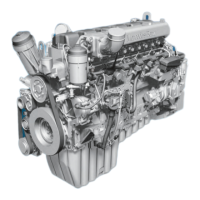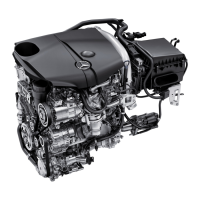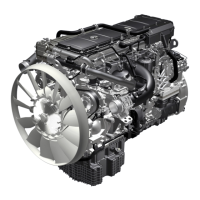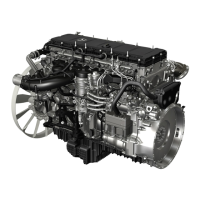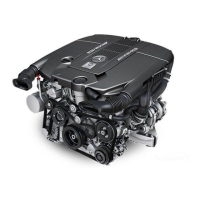Throttle valve lever in operating position
X
Remove the wire circlip from the ball socket
of the engine brake cylinder.
X
Press the ball socket off the ball coupling
of throttle valve lever :.
X
Check the engine brake cylinder, ball cou-
pling, ball socket and the throttle valve
shaft for wear.
X
Check the seating of the throttle valve lever
on the
throttle valve shaft and retighten the
clamp screw if necessary.
X
Lubricate the ball socket with heat-resist-
ant lubricant (part number A000 989 76
51).
X
Press the ball socket back onto the ball
coupling, fit the wire circlip.
X
When the engine brake is applied, throttle
valve lever : must rest on bracket ; in
the working position (cylinder extended).
The throttle valve lever must also rest on
bracket when the engine brake cylinder is
in the rest position (cylinder retracted). If
this is the case, the return spring preten-
sion of the engine brake cylinder is ade-
quate.
X
Check the position of the throttle valve
shaft: when the engine brake is in the rest
position, the notch must be horizontal. In
the working position, the notch must be
vertical.
Engine cooling system
Checking and correcting the fluid level
and the antifreeze/corrosion inhibitor
G
WARNING
When opening the coolant expansion tank,
there is a risk of scalding, due to hot coolant
spraying out.
The cooling system and coolant
expansion tank are pressurised when the
engine is at operating temperature. Wear
gloves and eye protection.
Open the coolant expansion tank only at a
coolant temperature below 50 † .
G
WARNING
Coolant contains glycol and is therefore toxic.
Do not swallow the coolant. See a doctor
immediately if you swallow coolant.
Make sure that coolant does not come into
contact with
skin, eyes or clothing. In case of
contact with eyes, rinse immediately with
plenty of clean water. Clean affected areas of
skin and clothing with soap and water imme-
diately. Change any affected clothing imme-
diately.
Only check the coolant level when the coolant
temperature is under 50 †. Check the anti-
freeze/corrosion inhibitor concentration
before correcting the coolant level. Only top
up with a prepared coolant having an anti-
freeze/corrosion inhibitor concentration of
50% by volume. corrosion inhibitor/anti-
freeze agent.
Before topping up, check the quality of the
antifreeze/corrosion inhibitor (Sheet. No.) in
the cooling system. Corrosion/antifreeze
additives compliant with Sheet 325.3 and
326.3 must not be mixed with those of Sheet
325.0/2 or 326.0/2. Only top up with corro-
sion inhibitor/antifreeze agent of the same
quality grade (Y page 48). This helps to pre-
vent damage to the engine.
Work schedules
73
Notes on maintenance
Z
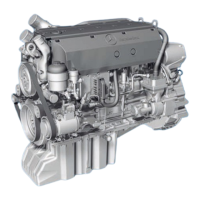
